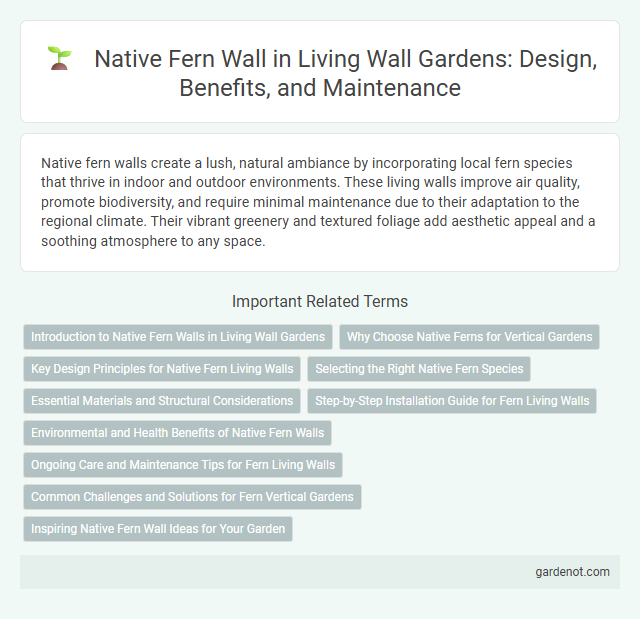Native fern walls create a lush, natural ambiance by incorporating local fern species that thrive in indoor and outdoor environments. These living walls improve air quality, promote biodiversity, and require minimal maintenance due to their adaptation to the regional climate. Their vibrant greenery and textured foliage add aesthetic appeal and a soothing atmosphere to any space.
Introduction to Native Fern Walls in Living Wall Gardens
Native fern walls create lush, textured vertical gardens that thrive in shaded environments, providing natural air purification and moisture regulation. These living walls incorporate species such as Boston fern (Nephrolepis exaltata) and maidenhair fern (Adiantum spp.), which adapt well to indoor and outdoor settings. Integrating native ferns into living wall gardens enhances biodiversity, supports local ecosystems, and offers sustainable greenery solutions.
Why Choose Native Ferns for Vertical Gardens
Native ferns thrive in vertical garden environments due to their adaptability to varying moisture levels and low light conditions. Their dense foliage enhances air quality by filtering pollutants while providing natural insulation and soundproofing. Selecting native ferns promotes biodiversity, supports local ecosystems, and reduces maintenance efforts compared to non-native species.
Key Design Principles for Native Fern Living Walls
Native fern living walls thrive when designed to mimic natural habitats, emphasizing shade tolerance and moisture retention to ensure fern health. Incorporating a layered planting strategy enhances biodiversity and structural depth, while selecting species with compatible growth rates prevents overcrowding and maintains aesthetic balance. Proper irrigation systems and breathable substrates support optimal root aeration and consistent hydration critical for native fern longevity.
Selecting the Right Native Fern Species
Selecting the right native fern species for a living wall requires consideration of local climate, light exposure, and humidity levels to ensure optimal growth and sustainability. Species such as Adiantum pedatum, Polystichum acrostichoides, and Dryopteris marginalis thrive in shaded, moist environments typical of native fern habitats. Proper selection enhances biodiversity, supports local ecosystems, and reduces maintenance needs while creating a visually appealing green wall.
Essential Materials and Structural Considerations
Native fern walls require a durable framework constructed from corrosion-resistant metals such as aluminum or galvanized steel to support the weight of soil and plants. High-quality, moisture-retentive substrates with excellent drainage properties are essential to maintain optimal hydration levels and prevent root rot. Proper irrigation systems integrated with water-resistant backing and secure mounting hardware ensure structural stability and longevity of the living wall.
Step-by-Step Installation Guide for Fern Living Walls
Begin the installation of a native fern living wall by securely mounting a durable, water-resistant frame on the chosen exterior or interior wall, ensuring proper drainage and irrigation access. Next, attach modular planting panels or felt pockets, then carefully plant native fern species like Polystichum and Dryopteris, selecting varieties suited to local humidity and light conditions for optimal growth. Finally, implement an automated drip irrigation system to maintain consistent moisture levels, and regularly monitor the wall for pest control and fern health to ensure long-lasting, vibrant greenery.
Environmental and Health Benefits of Native Fern Walls
Native fern walls enhance indoor air quality by naturally filtering pollutants and releasing oxygen, promoting a healthier living environment. Their ability to regulate humidity helps prevent mold growth and respiratory issues, contributing to overall well-being. Integrating native ferns supports local biodiversity, making these living walls an eco-friendly solution that benefits both humans and the environment.
Ongoing Care and Maintenance Tips for Fern Living Walls
Native fern walls thrive with consistent moisture and indirect light, ensuring their delicate fronds remain vibrant and lush. Regular misting and checking soil moisture levels prevent dehydration, while periodic pruning removes dead fronds to promote healthy growth. Monitoring for pests like aphids and applying organic treatments quickly safeguards the living wall's health and longevity.
Common Challenges and Solutions for Fern Vertical Gardens
Maintaining moisture levels is a common challenge for native fern walls, as ferns require consistently damp but well-drained conditions to thrive without root rot. To address this, installing an automated drip irrigation system with moisture sensors ensures optimal hydration while preventing overwatering. Proper selection of shade-tolerant fern species and regular pruning also promote healthy growth and reduce pest infestations common in vertical garden environments.
Inspiring Native Fern Wall Ideas for Your Garden
Incorporate lush native fern varieties such as sword fern, lady fern, and maidenhair fern to create a vibrant and low-maintenance living wall that enhances your garden's natural aesthetic. These ferns thrive in shaded, moist environments, offering textured greenery that supports local biodiversity and promotes a serene atmosphere. Optimize vertical space by combining different fern species with moss and shade-tolerant understory plants for a dynamic, eco-friendly garden feature.
Native fern wall Infographic

 gardenot.com
gardenot.com